Mapping the stability of malaria hotspots in Bangladesh from 2013 to 2016
- PMID: 29996835
- PMCID: PMC6042289
- DOI: 10.1186/s12936-018-2405-3
Mapping the stability of malaria hotspots in Bangladesh from 2013 to 2016
Abstract
Background: Malaria claims hundreds of thousands of lives each year, most of them children. A "malaria-free world" is the World Health Organization's vision, but elimination from the southeast Asian Region is hampered by factors including anti-malarial resistance and systematic underreporting. Malaria is a significant public health problem in Bangladesh and while there have been recent gains in control, there is large spatial and temporal heterogeneity in the disease burden. This study aims to determine the pattern and stability of malaria hotspots in Bangladesh with the end goal of informing intervention planning for elimination.
Results: Malaria in Bangladesh exhibited highly seasonal, hypoendemic transmission in geographic hotspots, which remained conserved over time. The southeast areas of the Chittagong Hill Tracts were identified as malaria hotspots for all 4 years examined. Similarly, areas in Sunamganj and Netrakona districts in the Northeast were hotspots for 2013-2016. Highly stable hotspots from 1 year predicted the following year's hotspot locations in the southeast of Bangladesh. Hotspots did not appear to act as sources of spread with no evidence of consistent patterns of contiguous spread or recession of hotspots as high or low transmission seasons progressed.
Conclusions: Areas were identified with temporal and spatial clustering of high malaria incidence in Bangladesh. Further studies are required to understand the vector, sociodemographic and disease dynamics within these hotspots. Given the low caseloads occurring in the low transmission seasons, and the conserved nature of malaria hotspots, directing resources towards these areas may be an efficient way to achieve malaria elimination in Bangladesh.
Keywords: Cartography; GIS; Heterogeneity; Hotspots; Incidence; Spatial epidemiology; Spatiotemporal.
Figures
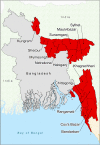
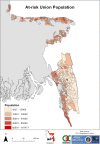
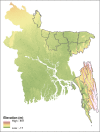


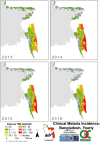
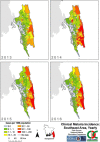

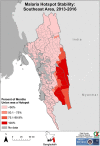



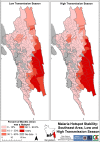
Similar articles
-
Malaria hotspots drive hypoendemic transmission in the Chittagong Hill Districts of Bangladesh.PLoS One. 2013 Aug 6;8(8):e69713. doi: 10.1371/journal.pone.0069713. Print 2013. PLoS One. 2013. PMID: 23936345 Free PMC article.
-
Genotyping of Plasmodium falciparum using antigenic polymorphic markers and to study anti-malarial drug resistance markers in malaria endemic areas of Bangladesh.Malar J. 2012 Nov 22;11:386. doi: 10.1186/1475-2875-11-386. Malar J. 2012. PMID: 23173674 Free PMC article.
-
Temporal trends in severe malaria in Chittagong, Bangladesh.Malar J. 2012 Sep 12;11:323. doi: 10.1186/1475-2875-11-323. Malar J. 2012. PMID: 22970881 Free PMC article.
-
Bangladesh in the era of malaria elimination.Trends Parasitol. 2023 Sep;39(9):760-773. doi: 10.1016/j.pt.2023.06.009. Epub 2023 Jul 25. Trends Parasitol. 2023. PMID: 37500334 Review.
-
An epidemiological overview of malaria in Bangladesh.Travel Med Infect Dis. 2013 Jan-Feb;11(1):29-36. doi: 10.1016/j.tmaid.2013.01.004. Epub 2013 Feb 21. Travel Med Infect Dis. 2013. PMID: 23434288 Review.
Cited by
-
Human behaviour directs household-level exposure to malaria vectors in Bandarban, Bangladesh.Malar J. 2022 Nov 29;21(1):355. doi: 10.1186/s12936-022-04375-4. Malar J. 2022. PMID: 36443751 Free PMC article.
-
Implementing radical cure diagnostics for malaria: user perspectives on G6PD testing in Bangladesh.Malar J. 2021 May 12;20(1):217. doi: 10.1186/s12936-021-03743-w. Malar J. 2021. PMID: 33980257 Free PMC article.
-
Micro-stratification of malaria risk in Nepal: implications for malaria control and elimination.Trop Med Health. 2019 Mar 27;47:21. doi: 10.1186/s41182-019-0148-7. eCollection 2019. Trop Med Health. 2019. PMID: 30976192 Free PMC article.
-
Mapping the travel patterns of people with malaria in Bangladesh.BMC Med. 2020 Mar 4;18(1):45. doi: 10.1186/s12916-020-1512-5. BMC Med. 2020. PMID: 32127002 Free PMC article.
-
Glucose-6-phosphate dehydrogenase activity in individuals with and without malaria: Analysis of clinical trial, cross-sectional and case-control data from Bangladesh.PLoS Med. 2021 Apr 23;18(4):e1003576. doi: 10.1371/journal.pmed.1003576. eCollection 2021 Apr. PLoS Med. 2021. PMID: 33891581 Free PMC article.
References
-
- WHO . World Malaria Report 2016. Geneva: World Health Organization; 2016.
-
- National Malaria Control Programme . Malaria national strategic plan: 2015–2020. Dhaka: Ministry of Health & Family Welfare; 2015.
-
- National Malaria Elimination Programme . National strategic plan for malaria elimination: a path to the phased elimination of malaria from Bangladesh. Dhaka: Ministry of Health and Family Welfare; 2017.
MeSH terms
Grants and funding
LinkOut - more resources
Full Text Sources
Other Literature Sources

